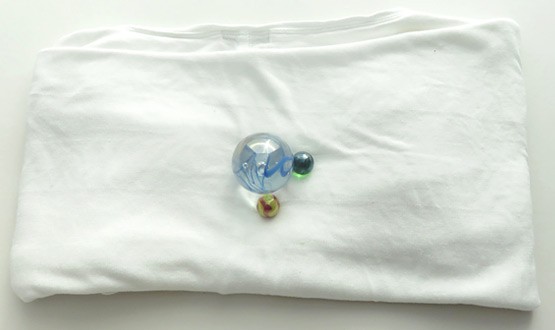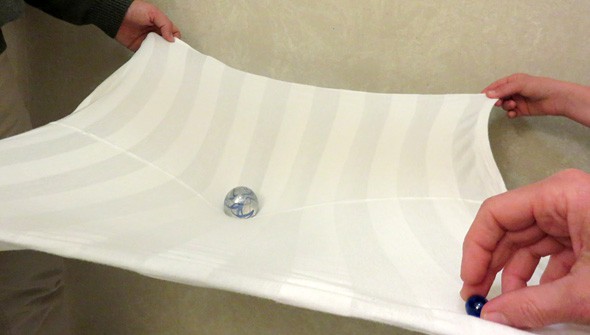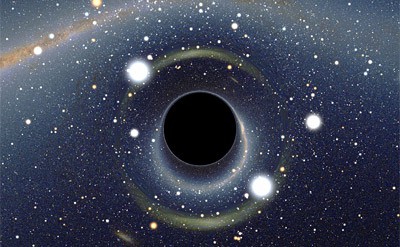Summary
Introduction
Do words like "general relativity", "gravity well", and "space-time continuum" sound scary? Don't worry, you don't have to be Albert Einstein to understand them! Try this fun activity to learn about these concepts and black holes, using some common household materials.Materials
- Stretchy fabric, like a polyester/lycra t-shirt (not cotton) or a large athletic bandage
- Round, heavy object like an apple, orange, or pool ball
- Two marbles or ping pong balls
- Two helpers
- Optional: marker and ruler
 Image Credit: Ben Finio, Science Buddies / Science Buddies
Image Credit: Ben Finio, Science Buddies / Science Buddies
Prep Work
Instructions
- Have your two volunteers hold your stretchy fabric by the corners, pull it taut, and hold it flat.
- This might seem silly, but put a marble somewhere on the fabric and watch it. What happens?
- Now roll a marble across the fabric and watch how it moves. What shape does its path take?
- Place your heavy, round object in the middle of the fabric. Make sure your volunteers still pull the fabric tightly enough that it does not have any wrinkles or bumps in it — try to make sure it's as smooth as possible. What happens to the fabric?
- With the heavy object still on the fabric, place the marble near the edge of the fabric and let it go. What happens now?
 Image Credit: Ben Finio, Science Buddies / Science Buddies
Image Credit: Ben Finio, Science Buddies / Science Buddies
- Now try to roll the marble from one side of the fabric to the other. Is it difficult? What shape does the marble's path form now?
- Experiment with rolling the marble across the fabric at different speeds.What happens if you roll the marble slowly? Faster? How does the shape of its path change? Is there a minimum speed you need to roll the marble to prevent it from getting sucked in towards the larger ball? Is it possible to roll the marble in a perfectly straight line?
- Try rolling two marbles on the fabric at once. Do the marbles appear to affect each other's motion (assuming they do not collide)?
What Happened?
You might think the results of this project are obvious at first. When you hold the fabric flat and put a marble on it, it doesn't move. If you roll the marble across the flat fabric, it moves in a straight line. No surprise there! When you place a heavy ball in the middle of your fabric, it causes the fabric to curve downward. Now, it's impossible to get the marble to hold still — it always rolls towards the middle. When you try to roll the marble in a line, it follows a curved path. As long as the marble doesn't get too close to the middle, you could probably still roll it from one end of the fabric to the other. However, if it gets too close to the center, the marble gets sucked in and cannot escape.
When you rolled two marbles at once, you probably noticed that (as long as they didn't collide), they did not really affect each other's motion. This is because the marbles are not heavy enough to introduce any additional curvature in the fabric. All of the curvature is due to the much heavier ball in the middle.
What does all this have to do with gravity and black holes? Read the Digging Deeper section to find out!
Digging Deeper
In "classical" or "Newtonian" mechanics, gravity is described as a force that acts between two objects, pulling them together. Technically, any object with mass exerts a gravitational force on other objects. However, this force between objects is usually too small for us to feel. You don't feel a sideways gravitational pull from the person standing next to you, for example, or even from bigger objects like cars or buildings. We only feel the gravitational force from huge masses like the Earth.
Einstein's theory of general relativity describes gravity a little differently. First, it describes space and time as a "fabric" or "continuum" called space-time (if you think of space as three-dimensional, and you add time as another dimension, then you get something that has four dimensions). General relativity describes gravity as the curvature of this four-dimensional space-time, which is caused by mass. So, large masses like the Earth cause a large curvature in space-time, whereas smaller masses like our bodies barely cause any curvature. In this activity, your stretchy fabric represented space-time and the heavy ball in the middle was a large mass like the Earth — it caused space-time to curve. Smaller masses like the marbles were affected by this curvature in space-time, but were not heavy enough to cause much curvature on their own.
While the Earth's gravity is very strong, we can build rockets and spaceships that can escape it and fly off to the rest of the solar system. We can also send electromagnetic radiation, like light or radio waves, out into space. A black hole is an object in space with so much mass, and gravity so strong (it curves space-time so much), that nothing can escape it, not even light. Anything that passes too close to a black hole (inside a region called the event horizon) will be sucked in. You might wonder how astronomers know black holes exist. After all, if light cannot escape them (meaning they do not emit light or reflect light), how can we see them? Scientists know black holes exist because we can observe their effects on other celestial bodies like stars. For example, the orbit of a star may be affected by the gravity of a nearby black hole, and we can observe matter being sucked into black holes (before it disappears behind the event horizon). Imagine if your fabric curved so much that you could never roll the marble fast enough to get near the middle and still escape — that would be like a black hole!
Ask an Expert
For Further Exploration
- If you don't mind drawing on your fabric (don't do this with a new t-shirt!), lay it flat on a table. Use a ruler and marker to draw a grid of squares on the fabric. The grid should consist of lines that intersect each other at right angles. Now repeat the activity. What happens to the grid?









